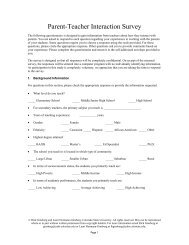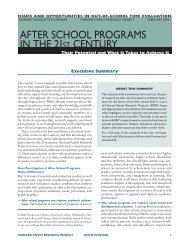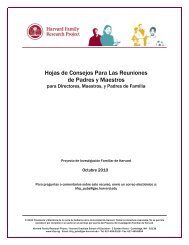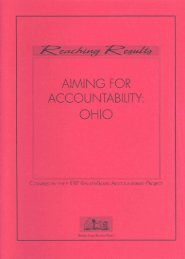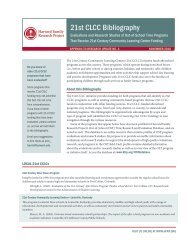Download a PDF of this case study - Harvard Family Research Project
Download a PDF of this case study - Harvard Family Research Project
Download a PDF of this case study - Harvard Family Research Project
You also want an ePaper? Increase the reach of your titles
YUMPU automatically turns print PDFs into web optimized ePapers that Google loves.
Examples <strong>of</strong> Successful District and State Work<br />
Epstein describes the Network’s role as a facilitator <strong>of</strong> school, district, and<br />
state linkages: “The actual work has to be done at the site, but we can help<br />
to change what that effort looks like. And we have helped change the way<br />
districts help their schools, and states help their districts.”<br />
Barbara Jarzyniecki, Executive Director <strong>of</strong> Public Engagement and<br />
Communications Services in the district <strong>of</strong> Rochester, New York has<br />
organized a team <strong>of</strong> parents who are actively and positively affecting<br />
families in their local schools. The parent group submitted a proposal and<br />
budget to the district's board <strong>of</strong> education to develop parent action centers.<br />
To start the process, the parent group members also attended all 60 open<br />
houses in the district to inform other parents <strong>of</strong> their plan. With district<br />
approval and support, the first <strong>of</strong> four parent action centers has already<br />
opened. Staffed by trained parents, the center <strong>of</strong>fers information and<br />
guidance to parents on all issues related to their children's education. For<br />
example, the center <strong>of</strong>fers links to community resources and parent liaisons<br />
in the schools, houses a library <strong>of</strong> materials on education and family<br />
involvement, and conducts computer classes for parents. These four centers<br />
will benefit from a parent library and connections to local agencies (As<br />
described in http://www.rochester.k12.us/pac/index.htm, March 29, 2000).<br />
Dr. Suzanne Darmer, Coordinator <strong>of</strong> Federal and State Programs for the<br />
district <strong>of</strong> Columbus, Ohio, has created a traveling literacy academy for<br />
young children and families. Dr. Darmer cites earlier advice from Joyce<br />
Epstein in explaining the origin <strong>of</strong> <strong>this</strong> early intervention strategy designed<br />
to promote good literacy practices. Epstein argued that learning at home is<br />
a critical ingredient to student achievement. To incorporate <strong>this</strong> concept,<br />
the program uses a van, equipped with books, tools, and a reading<br />
specialist, that travels to community and school sites to teach and model<br />
good literacy practices and provide tools and materials to families.<br />
The work <strong>of</strong> other school districts and state departments <strong>of</strong> education are<br />
also noteworthy. For example, in Baltimore, Maryland, the training and<br />
support <strong>of</strong> a full-time district-level facilitator and other district-level<br />
supports allowed partnership programs to move from eight pilot schools to<br />
nearly citywide participation (Sanders & Epstein, 1999). Examples <strong>of</strong> state<br />
work supporting the work <strong>of</strong> districts and schools include web sites, grant<br />
funding, public service announcements, annual conferences, integrated<br />
training efforts, networking support, and mission statements.<br />
For more information and examples see the National Network’s web site,<br />
http://www.csos.jhu.edu/p2000 and follow links to Publications–Type 2<br />
newsletters and In the Spotlight-Promising Partnership Practices.<br />
Finally, the Network’s conceptual framework calls for school collaborations with the<br />
community. The Network has conducted research that provides guidance on how to<br />
strengthen these connections and recently has shared findings with its members (National<br />
Network <strong>of</strong> Partnership Schools, 1999b; Sanders, 1999). This research shows that almost<br />
half <strong>of</strong> all community partners are businesses, which suggests that other community<br />
partners may be underutilized. Most partnerships are also student-centered, rather than<br />
- 8 -





